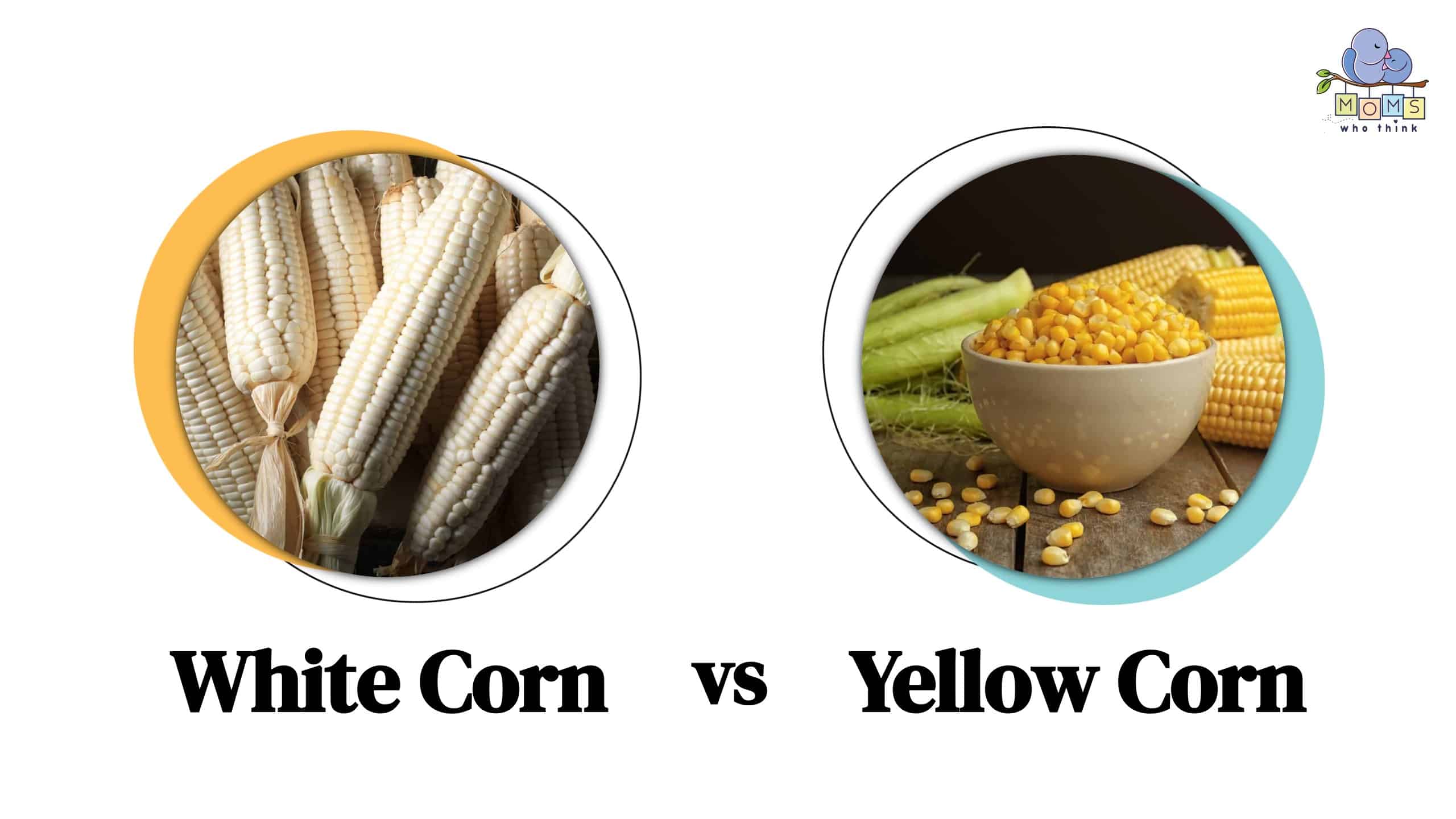Whether you prefer it popped or on the cob, corn is a delicious part of many meals. No matter how you choose to eat it, you’ve probably noticed there are different varieties of corn, with two of the most common varieties being white and yellow corn. Have you ever wondered if there’s any difference between white corn vs yellow corn?
The main difference between the two types of corn is the amount of beta-carotene, which is what makes the kernels yellow. Yellow corn contains higher amounts of beta-carotene, which leads to the kernels being yellow and also adds slightly more nutritional value to this type of corn.
Keep reading to find out more about the differences in the appearance and nutritional values of white corn vs yellow corn.
- The must-have convenient reference guide for every home cook!
- Includes more than 8,000 substitutions for ingredients, cookware, and techniques.
- Save time and money on by avoiding trips to grab that "missing" ingredient you don't really need.
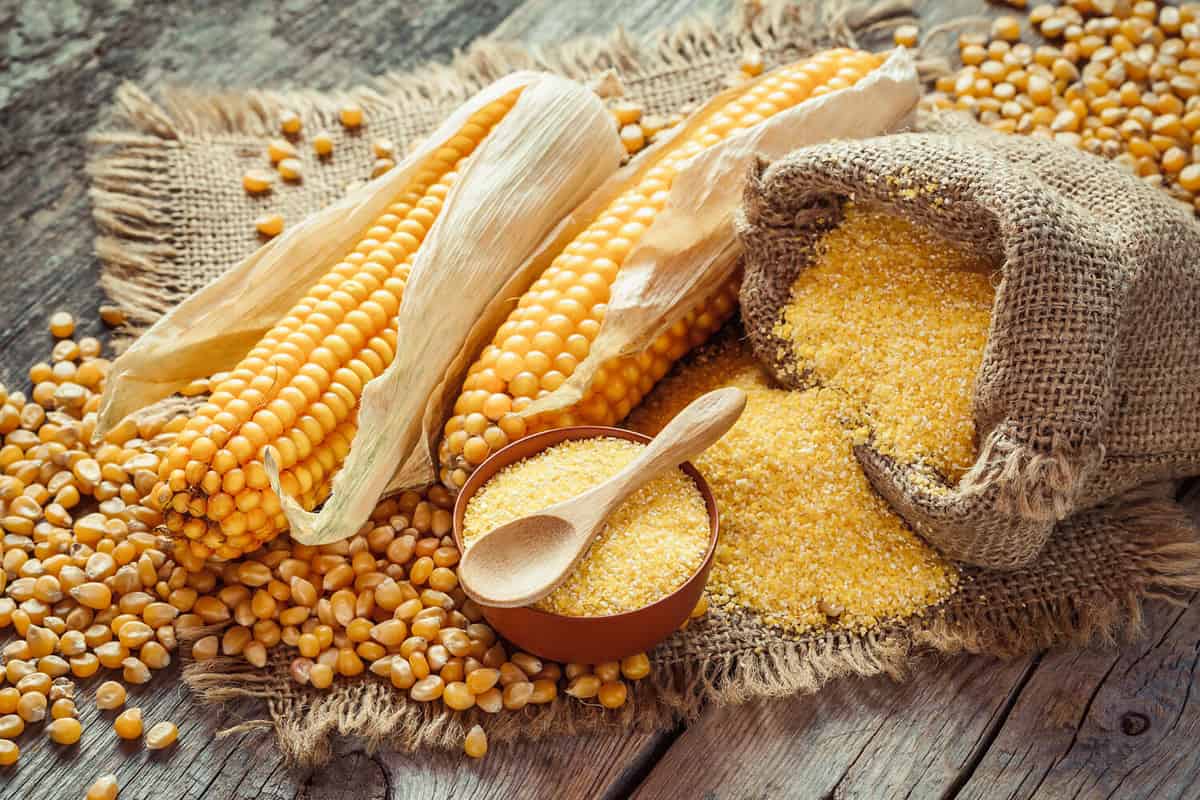
White corn and yellow corn have more in common than most people realize.
©Chamille White/Shutterstock.com
White Corn vs Yellow Corn: What Is the Difference?
Corn, also commonly called maize, has been around for thousands of years. Although there are far more varieties of corn than the types we’re used to seeing in the grocery store, the most popular colors are yellow and white.
There are two main differences between white corn and yellow corn: appearance and nutritional values. The most obvious difference between these two types of corn is their appearance. While the kernels of white corn are usually white, they can also be more of a cream color. Yellow corn, on the other hand, can be bright or pale yellow, depending on the type of corn.
There is also a slight difference in their nutritional values. Yellow corn kernels get their color from the pigment, beta-carotene. Beta-carotene is a significant source of vitamin A since that’s what our bodies convert this pigment to. However, other than the amount of beta-carotene, the nutritional values of white corn vs yellow corn are nearly identical.
Many think that yellow corn is sweeter than white corn because of its color, but that’s not necessarily the case. The sweetness of the corn generally depends on the type of corn, not the color. Most of the yellow and white corn we see in the store is sweet corn, so both varieties will be sweet.
Main Differences Between White Corn vs Yellow Corn
There are more similarities between white corn and yellow corn than there are differences, but even though they come from the same type of corn, they’re not exactly the same. The 2 main differences between white corn and yellow corn are:
- Appearance
The first thing you’ll notice when you see white corn or yellow corn is their color. While the kernels of white corn range from white to creamy, yellow corn kernels are generally pale yellow or bright yellow. The color difference is caused by the amount of beta-carotene, which is a pigment that gives plants their color. - Nutritional Values
Since yellow corn has higher levels of beta-carotene than white corn, there is a slight difference in nutritional values. Our bodies convert beta-carotene to vitamin A, which means yellow corn is a better source of vitamin A. Other than this distinction, the nutritional values of white corn vs yellow corn are the same.
Nutritional Values of White Corn vs Yellow Corn
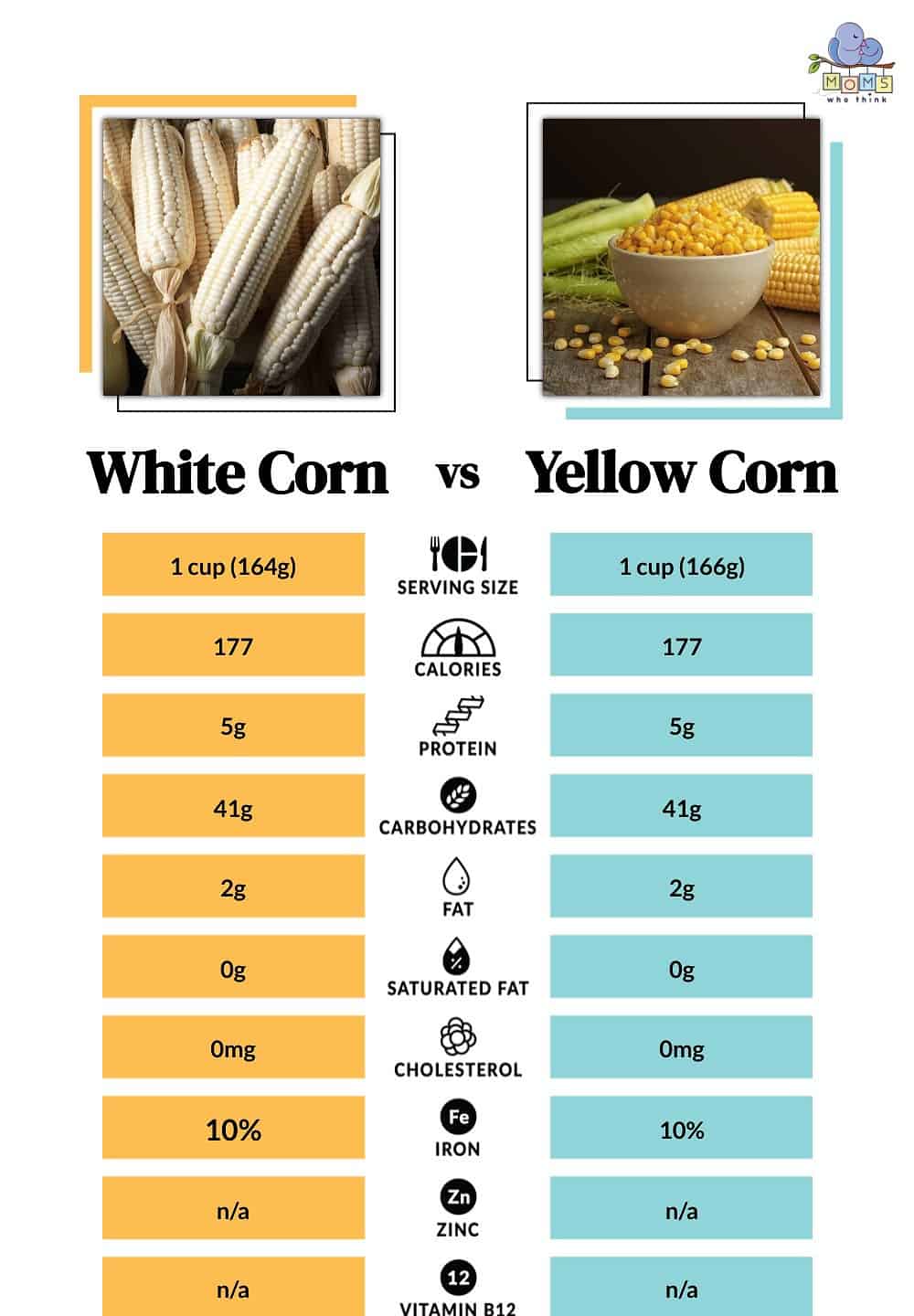
©
What Is Corn?
White corn and yellow corn are both varieties of the same type of corn, also known as sweet corn. Corn is sometimes considered a vegetable and other times considered a grain, depending on when it's harvested.
If corn, whether white or yellow, is harvested when it’s dry and fully mature, it’s considered a grain. However, if it’s harvested when it’s fresh, it’s considered a vegetable. Corn has a variety of uses. As humans, we eat quite a bit of corn, but it’s also used as livestock feed and can even be used as biofuel when it’s converted to ethanol.
The history of corn goes over 9,000 years when native people in Mexico first domesticated it. Since then, it’s become a staple in many countries and it’s an essential part of agriculture in the United States.
Is White Corn Sweeter Than Yellow Corn?
When asked about the difference between white corn and yellow corn, there’s a common misconception that yellow corn is sweeter than white corn. However, it’s not the color of the corn that determines its sweetness. Instead, it’s the type of corn.
Since the white corn and yellow corn you usually find in the store are both varieties of sweet corn, they both have their own level of sweetness. Other types of corn, such as dent corn, aren’t sweet like yellow and white corn because they don’t have a high sugar content. However, you won’t find dent corn in your grocery aisles since this type of corn is mostly used for animal feed.
If you purchase fresh corn or canned corn in the grocery store, it will be a variety of sweet corn. Even though the main difference between white and yellow is the amount of beta-carotene, you won’t notice much of a difference in the flavor.
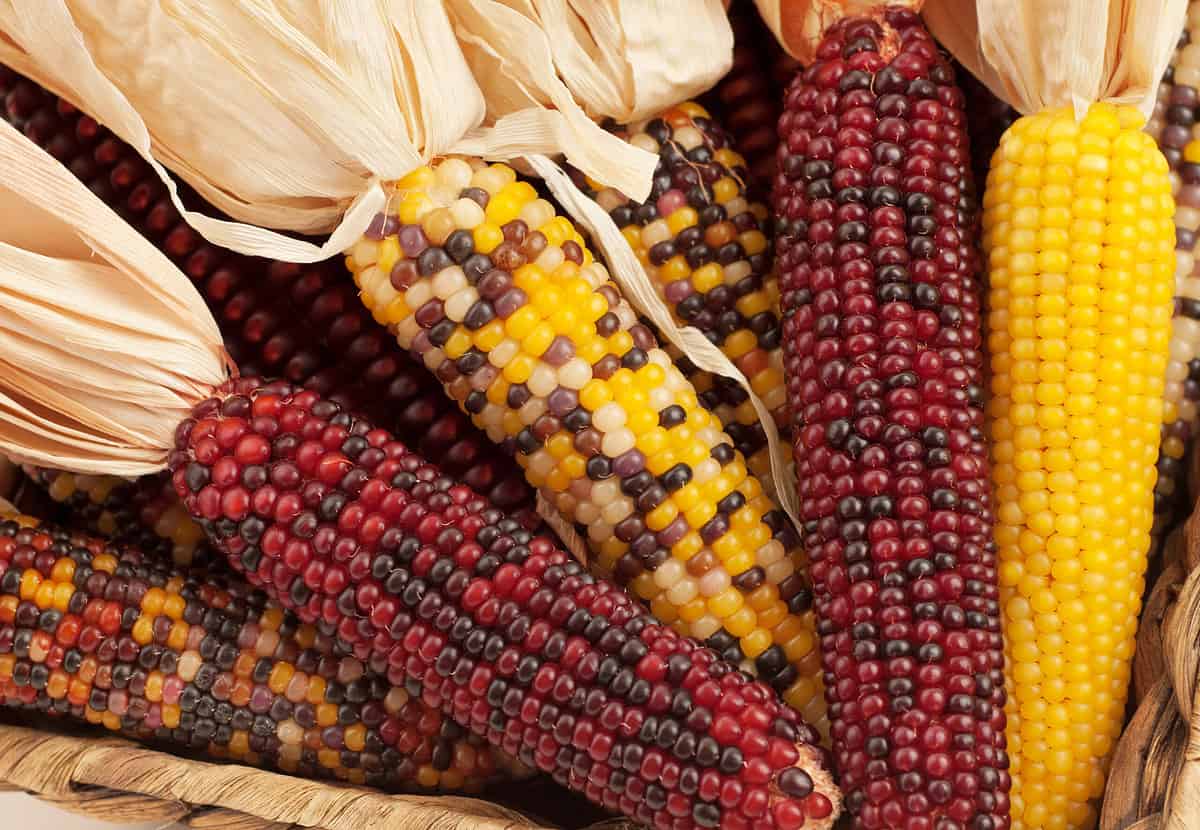
There are many varieties of corn out there, but they mostly fall within six major categories.
©Candace Hartley/Shutterstock.com
Different Types of Corn
If the type of corn is what determines how sweet it is, you may wonder how many types of corn there are. While there are numerous varieties of corn, they generally fall under six different categories. These categories include:
Dent corn
Dent corn is a type of corn with a high starch content. This specific type can be recognized by the dent in each kernel and is also known as field corn or grain corn. Dent corn isn’t sweet and it usually ends up being part of animal feed. It’s also sometimes used as a grain in chips or corn flour.
Sweet corn
Sweet corn is the type of corn we’re used to eating and it’s the most popular type you’ll see in the grocery store or farmer’s market. This type of corn has a high sugar content compared to dent corn, which is what makes it delicious to eat when it’s fresh. Sweet corn generally comes in white or yellow varieties.
Flint corn
Flint corn is the type of corn you see in fall decorations. It’s sometimes called Indian corn or calico corn, but no matter what it’s called, flint corn is usually colorful. There are a lot of nutrients in flint corn and the grains are often used for things like cornmeal or grits.
Heirloom corn
Heirloom corn is a specific type of corn that is made from carefully selected seeds that farmers preserve and pass down from one generation to the next. Unlike mass-produced corn, heirloom corn is not genetically modified. There can be many varieties of heirloom corn, but many are more colorful than the corn you see in the grocery store.
Waxy Corn
Waxy corn, like dent corn, is a type of field corn that’s characterized by its waxy exterior. Compared to sweet corn, waxy corn contains a higher amount of amylopectin, which is a type of starch. Waxy corn is often called glutinous corn and is used as a stabilizing factor in many food products.
Popcorn
Contrary to what some believe, you can’t make popcorn from the dried kernels of any type of corn. This specific type of corn is used for making popcorn because of its texture and flavor. In the United States, we produce more popcorn than any other country, especially in states like Kentucky, Indiana, Iowa, Illinois, and Nebraska.
Which is Healthier: White Corn vs Yellow Corn?
While the difference in nutritional values is relatively minimal, yellow corn does contain higher amounts of beta-carotene. However, the amounts of beta-carotene in yellow corn aren’t significant. 100 grams of yellow corn may contain about 47 mcg of beta-carotene, compared to 1 mcg in white corn. Overall, 47 mcg is less than 1% of your daily value.
Both white and yellow corn can be a healthy addition to any meal. Sweet corn is generally a good source of fiber and antioxidants. You can add corn to salads, tacos, wraps, soups, and more.
Can You Substitute White Corn for Yellow Corn?
If you’re including corn in a recipe, you might wonder which corn would go best with your meal: white or yellow corn? In most cases, yellow corn can be substituted for white corn and vice versa. Considering how similar they are, it’s easy to swap one for the other in any recipe.
Within the category of sweet corn, there are typically three varieties: normal, sugar-enhanced, or super-sweet. The super-sweet variety is generally the one you’ll find for sale nowadays, but it doesn’t matter whether the kernels are white or yellow. Either way, you’ll probably notice your corn is sweet, which is how it tastes best!
- The must-have convenient reference guide for every home cook!
- Includes more than 8,000 substitutions for ingredients, cookware, and techniques.
- Save time and money on by avoiding trips to grab that "missing" ingredient you don't really need.
Main Differences in White and Yellow Corn
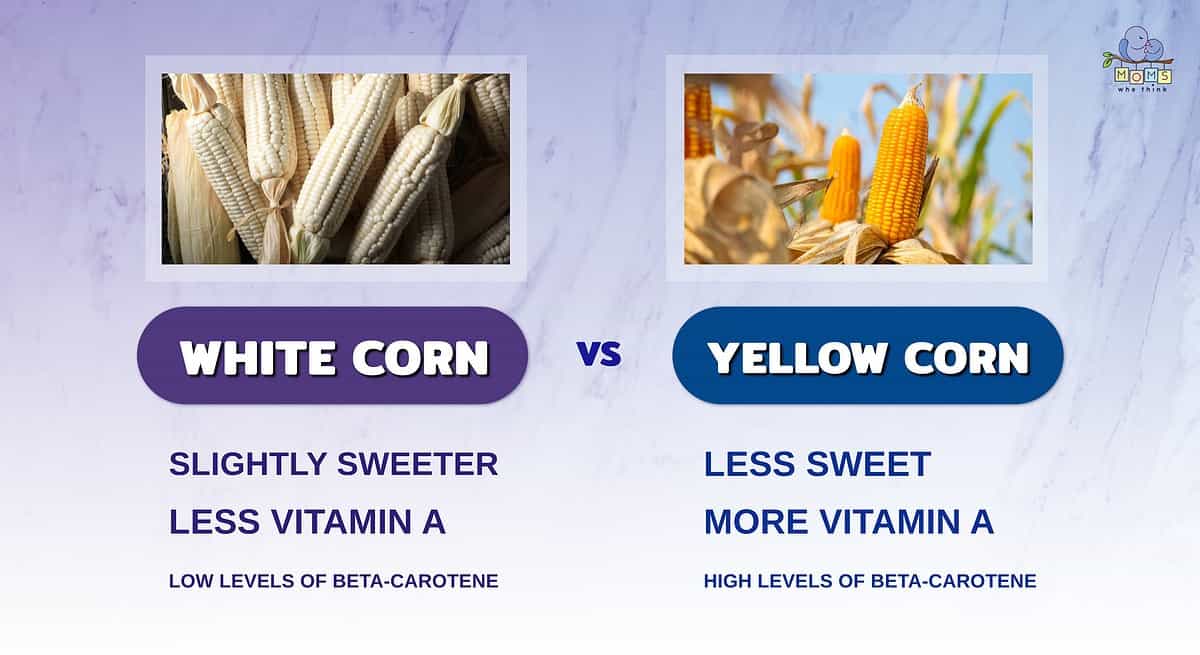
- Both of the corns are very similar but white corn is slightly sweeter.
- Yellow corn gets its color from a higher level of beta-carotene.
- White corn isn't always pure white but can show up as a greyish or eggshell color.
Corn Recipes
PrintChicken Piccata and Yellow Corn on the Cob
- Yield: 4 servings
Ingredients
4 boneless, skinless chicken breast halves (about 1 1/4 pounds)
1/4 cup all-purpose flour
1/4 cup butter
2 cloves garlic, finely chopped
1 cup chicken broth
2 Tablespoons lemon juice
1/2 teaspoon pepper
1 bag frozen corn on the cob, microwave steamable
Instructions
1. Coat chicken with flour, shaking off excess.
2. Melt butter in 12 inch skillet over medium-high heat.
3. Cook chicken and garlic and butter 15 to 20 minutes, turning chicken once, until juice of chicken is no longer pink when cut through thickest part.
4. Add chicken broth and lemon juice; sprinkle with pepper. Heat until hot.
5. While chicken is cooking, prepare frozen corn.
6. Serve with warm buttered rolls.
- Cheesy Creamed Corn
- Sesame Shrimp with Snow Peas and Baby Corn
- Buttermilk Pan Fried Chicken with Creamed Corn
- Sausage-Corn Chowder
- Beef and Corn Casserole with Pepper Jack Cheese
